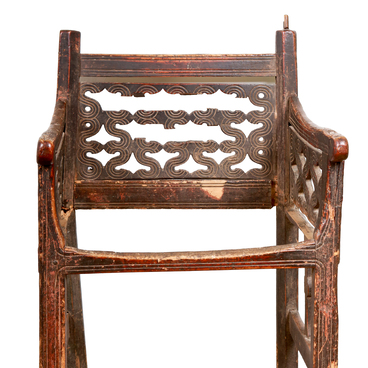The collection of the Kasimov Museum-Reserve contains a battle-flail — a combat weapon that was widely used in the territory of the Lower Volga and Don Regions in the 5th–9th centuries, and from there it came to Ancient Rus in the 10th century.
The battle-flail consisted of an iron weight of about 200-300 grams, which was attached on a belt or chain to a short wooden handle. There was also another version of the battle-flail — on a loop that was wrapped around the wrist. The name of the tool came from similar words in Turkic languages, for example in Tatar, where the word ‘flail’ meant ‘club’.
Initially, the weights of battle-flail had the shape of an egg and a smooth surface and were made of heavy and dense bone. Later, as other materials became available, bronze and iron hammered weights appeared, which could be covered with spikes or small drops.
The weights were not empty inside: to enhance the impact from the blow and increase the weight of the weapon, the space inside was often filled with lead. Because of this, the battle-flail was effective in close combat: it could cause serious injuries to the enemy, including fractures.
The weapon was popular among different population groups. For example, robbers on the roads preferred a battle-flail because of its small size: this allowed them to carry it next to their chest before an attack. Due to its simple design and low cost, ordinary workers took the battle-flail with them — for example, to defend themselves when traveling.
The military also used the weapon: it was convenient to carry it in a sleeve, it did not take up any extra space. For example, the battle-flail was part of the armament of the Russian cavalrymen at the beginning of the 16th century. The Roman diplomat Sigismund von Herberstein wrote that the horsemen had in their arsenal ‘a bow, arrows, an ax and a stick like a mace, called a “kisten” (battle-flail) in Russian.’
When firearms began to spread in Russia, concussion weapons began to be used less often. Despite this, the battle-flail remained popular: the tool was cheap to manufacture and was potent. In the 18th century, it continued to be used by the military, criminals, and even rebellious peasants. For example, the battle-flail was in service with the rebels during the Pugachev rebellion in the 1770s.
The battle-flail consisted of an iron weight of about 200-300 grams, which was attached on a belt or chain to a short wooden handle. There was also another version of the battle-flail — on a loop that was wrapped around the wrist. The name of the tool came from similar words in Turkic languages, for example in Tatar, where the word ‘flail’ meant ‘club’.
Initially, the weights of battle-flail had the shape of an egg and a smooth surface and were made of heavy and dense bone. Later, as other materials became available, bronze and iron hammered weights appeared, which could be covered with spikes or small drops.
The weights were not empty inside: to enhance the impact from the blow and increase the weight of the weapon, the space inside was often filled with lead. Because of this, the battle-flail was effective in close combat: it could cause serious injuries to the enemy, including fractures.
The weapon was popular among different population groups. For example, robbers on the roads preferred a battle-flail because of its small size: this allowed them to carry it next to their chest before an attack. Due to its simple design and low cost, ordinary workers took the battle-flail with them — for example, to defend themselves when traveling.
The military also used the weapon: it was convenient to carry it in a sleeve, it did not take up any extra space. For example, the battle-flail was part of the armament of the Russian cavalrymen at the beginning of the 16th century. The Roman diplomat Sigismund von Herberstein wrote that the horsemen had in their arsenal ‘a bow, arrows, an ax and a stick like a mace, called a “kisten” (battle-flail) in Russian.’
When firearms began to spread in Russia, concussion weapons began to be used less often. Despite this, the battle-flail remained popular: the tool was cheap to manufacture and was potent. In the 18th century, it continued to be used by the military, criminals, and even rebellious peasants. For example, the battle-flail was in service with the rebels during the Pugachev rebellion in the 1770s.

